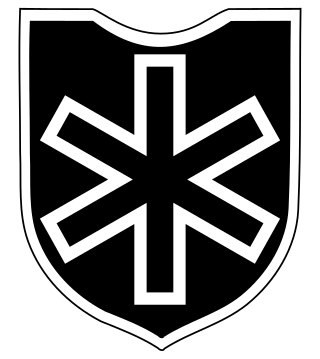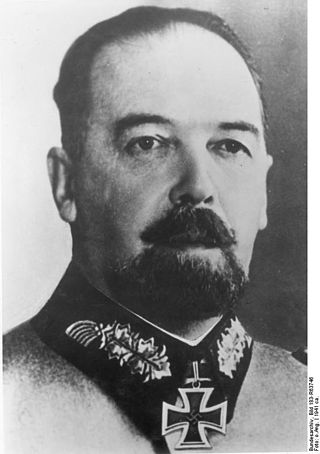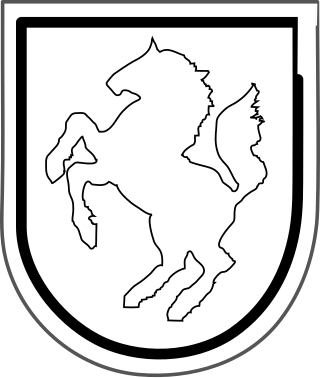
The 6th SS Mountain Division Nord was a World War II mountain infantry division of the Waffen-SS, the military wing of the German Nazi Party, primarily consisting of ethnic Germans along with some Norwegian and Swiss volunteers. It was the only Waffen-SS division to operate in the Arctic Circle.

The 3rd Mountain Division was a formation of the German Wehrmacht during World War II. It was created from the Austrian Army's 5th and 7th Divisions following the Anschluss in 1938.

The 1st Mountain Division was an elite formation of the German Wehrmacht during World War II, and is remembered for its involvement in multiple large-scale war crimes. It was created on 9 April 1938 in Garmisch Partenkirchen from the Mountain Brigade which was itself formed on 1 June 1935.

III Army Corps was a corps level formation of the German Army during World War II.

Franz Friedrich Böhme was an Army officer who served in succession with the Austro-Hungarian Army, the Austrian Army and the German Wehrmacht. He rose to the rank of general during World War II, serving as Commander of the XVIII Mountain Corps, Hitler's Plenipotentiary Commanding General in the Balkans, and commander-in-chief in German-occupied Norway during World War II. After the war, Böhme was transferred to U.S. custody as a defendant in the Hostages Trial on charges of having massacred thousands of Serbian civilians. He committed suicide in prison.

The 32nd Infantry Division of the German Army was mobilized on 1 August 1939 for the upcoming invasion of Poland. At that time, it consisted of the usual German Infantry Division elements: three infantry regiments of three battalions each, one three-battalion regiment of light artillery, one battalion of heavy artillery, a Panzerjäger (anti-tank) Battalion, a reconnaissance (Aufklärungs) Battalion, a Signals Battalion, a Pioneer (Engineer) Battalion, and divisional supply, medical, and administrative units.

Julius 'Papa' Ringel was an Austrian general in the armed forces of Nazi Germany during World War II. He fought in the Western and Eastern fronts, as well as the Balkan Campaign. Ringel commanded the 3rd Mountain Division, 5th Mountain Division, LXIX Corps, Wehrkreis XI and the Army Corps Ringel. He was a recipient of the Knight's Cross of the Iron Cross with Oak Leaves.

Hans Kreysing was a German general who commanded the 3rd Mountain Division and the 8th Army. He was a recipient of the Knight's Cross of the Iron Cross with Oak Leaves and Swords.

The 30th Infantry Division of the Wehrmacht was created on 1 October 1936 in Lübeck and mobilized on 26 August 1939 for the upcoming invasion of Poland. At that time, it consisted of the usual German infantry division elements: three infantry regiments of three battalions each, one three-battalion regiment of light artillery, one battalion of heavy artillery, a panzerjager (anti-tank) battalion, an aufklärungs (reconnaissance) battalion, a signals battalion, a pioneer (engineer) battalion, and divisional supply, medical, and administrative units.
II Army Corps was a corps in the German Army during World War II.

V Army Corps was a corps in the German Army during World War II.

German XI. Corps was a corps in the German Army during World War II.

L Army Corps was a corps in the German Army during World War II.
The XV Mountain Corps was a German military formation that commanded German forces conducting counter-insurgency operations against the Yugoslav Partisans in the Independent State of Croatia during World War II.
XXXXIX Mountain Corps was a mountain warfare corps of the German Army during World War II.
X Army Corps was a corps in the German Army during World War II. It was formed in mid-May 1935 from the Cavalry Division.

XVII Army Corps was a corps in the German Army during World War II. The corps was formed in Vienna on 1 April 1938 after the Annexation of Austria.

The XXIV Army Corps was a unit of the German Army during World War II. The unit was re-designated several times; originally being Generalkommando der Grenztruppen Saarpfalz, later Generalkommando XXIV. Armeekorps, then XXIV. Armeekorps (mot.) and finally XXIV. Panzerkorps.

XXXXII Army Corps was a corps in the German Army during World War II.

XXXXIII Army Corps was a corps in the German Army during World War II.















